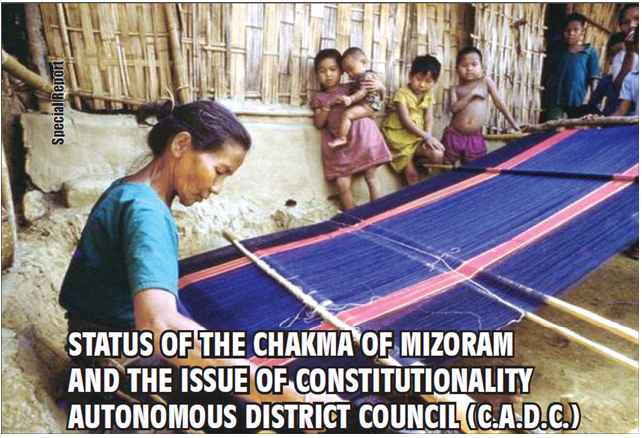
The issue of constitutionality and legality of the creation of the CADC
The authority for amending any provision of the Sixth Schedule lies with the Parliament, as such the State Legislative Assembly or any other legislatures do not have any say with regard to the provision of the Sixth Schedule to the Constitution of India. It shall be ascertained how the provision for amendment of the Sixth Schedule to the Constitution of India has been incorporated in the Sixth Schedule itself. Any issue concerning constitution matter shall be analyzed correctly only from the constitutional provision and constitutional direction itself instead of arguing it from other perspectives. It is incorporated in Paragraph 21, sub-paragraph (1) of the Sixth Schedule to the Constitution of India that “Parliament may from time to time by law amend by way of addition, variation or repeal any of the provision of this schedule and when the schedule is so amended, any reference to this schedule in this constitution shall be construed as a reference to such schedule as so amended”. Paragraph 21 subparagraph (2) “No such law as is mentioned in sub-paragraph (1) of this paragraph shall be deemed to be an amendment of this constitution for the purpose of article 368”
It is stated clearly in Paragraph 21, sub-paragraph (1) of the Sixth Schedule  that any part of the provision of the Sixth Schedule can be amended in the form addition,variation or repeal by Parliament and it is further clarified in Paragraph 21, sub-paragraph (2) that any amendment of the Sixth Schedule shall not be regarded as normal amendment as per the provision of Article 368 of the Constitution of India. It should be noted from the constitutional wording of Paragraph 21 of the Sixth Schedule that any provision of the Sixth Schedule can be amended by Parliament by just simple majority in the form of addition, variation or repeal by Parliament but any legislature in India other than Parliament is not authorized to exercise any legislative powers with regard to the Sixth Schedule.It is evident that so long as Parliament is involved and any modification and additions have been made as per the legislation of Parliament, constitutionality and legality of that processed cannot be questioned. However, if any slight modifications and changes have been introduced without the involvement of Parliament, constitutionality and legality can be questioned. Thus, the question of constitutionality and legality do not arise so long as Parliament is involved in the process and if actions have been initiated as per the legislation of the Parliament.
that any part of the provision of the Sixth Schedule can be amended in the form addition,variation or repeal by Parliament and it is further clarified in Paragraph 21, sub-paragraph (2) that any amendment of the Sixth Schedule shall not be regarded as normal amendment as per the provision of Article 368 of the Constitution of India. It should be noted from the constitutional wording of Paragraph 21 of the Sixth Schedule that any provision of the Sixth Schedule can be amended by Parliament by just simple majority in the form of addition, variation or repeal by Parliament but any legislature in India other than Parliament is not authorized to exercise any legislative powers with regard to the Sixth Schedule.It is evident that so long as Parliament is involved and any modification and additions have been made as per the legislation of Parliament, constitutionality and legality of that processed cannot be questioned. However, if any slight modifications and changes have been introduced without the involvement of Parliament, constitutionality and legality can be questioned. Thus, the question of constitutionality and legality do not arise so long as Parliament is involved in the process and if actions have been initiated as per the legislation of the Parliament.
As stated above, the process for emergence of the CADC began with the trifurcation of the PLRC. Therefore, it should first be analyzed how the process for trifurcation of the PLRC had been initiated. It is evident that Paragraph 1, sub-paragraph (3) of the Sixth Schedule gives power to the Governor to (c ) create a new autonomous district (d) increase the area of any autonomous district (e) diminish the area of any autonomous district (f) unite two or more autonomous districts or parts thereof so as to form one autonomous district (ff) alter the name of autonomous district (g) define the boundaries of any autonomous district. Yet, Governor cannot make order under clauses (c), (d), (e) and (f ) till consideration of report appointed under subparagraph (1), Paragraph 14 of the Sixth Schedule. However, even in this case, Governor can only issue notification or order only after it is passed and approved by the Parliament.
To read the further article please get your copy of Eastern Panorama March issue @http://www.magzter.com/IN/Hill-Publications/Eastern-Panorama/News/ or mail to contact @easternpanorama.in


